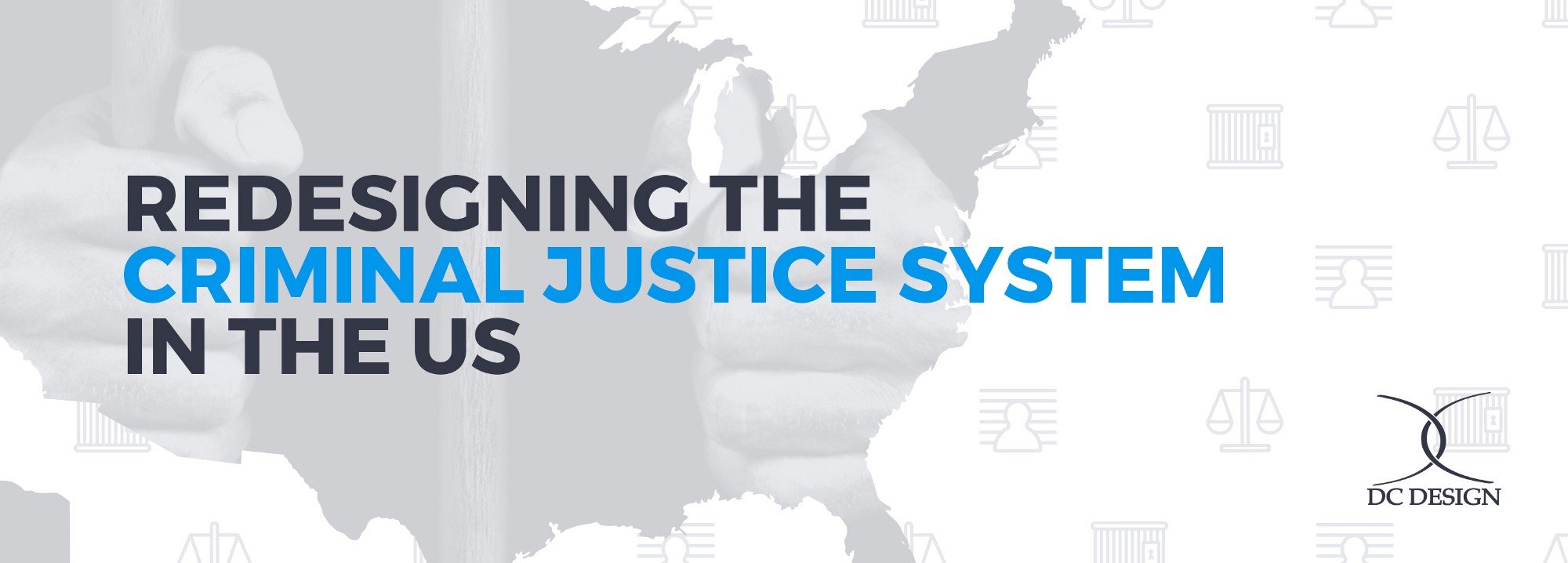Redesigning the Criminal Justice System in the US
We are launching a new series on criminal justice reform that looks at the specific challenges we currently face as a country in our prisons and jails, how we got here, and what we can do about it.
Throughout this series we’ll be interviewing leaders in criminal justice, detailing insights from our own consulting work with governments, and writing about how these issues intersect with other social systems like those of foster care, healthcare, education and more.
We start off with a quick, non-exhaustive understanding of the current situation.
First four definitions to keep in mind:
A jail is a county run imprisonment facility that holds low-level offenders, those still awaiting trial, or those who have been convicted but not yet transferred to prison.
A prison refers to a state or federally operated imprisonment facility that typically hold those convicted of more serious crimes or those who will be in jail for longer periods of time. These do not always go hand-in-hand.
Probation refers to a sentence to be served out of jail but under supervision of the criminal justice system. It is given by a judge at the trial.
Parole also refers to a sentence that is served out of jail and under supervision of the criminal justice system. However, it is not part of an initial sentence and is given on a case by case basis at a later time.
If we start by looking at the overall incarceration rate across countries, we see that the US imprisons more people than any other country in the world.
Infographic: Lily Boyce/ DC Design
In October 2013, the incarceration rate of the United States of America was the highest in the world, at 716 per 100,000 of the national population. While the United States represents about 4.4 percent of the world’s population, it houses around 22 percent of the world’s prisoners. (International Center for Prison Studies)
Major changes in our criminal justice laws and practices has led to incredible expansion of our prison and jail populations over the last 40 years.
Infographic by Lily Boyce/ DC Design
Between 1980 and 2015, the number of people incarcerated in America increased from roughly 500,000 to over 2.2 million — NAACP
Taking a broader look at those who are in jail, prison, on parole, or on probation, we see that the number of people being monitored by our criminal justice system is actually much higher than the 2.2 million cited. If we look at those who are being monitored by the government corrections system as a whole, we see that even more people are impacted.
An estimated 6,899,000 persons were under the supervision of adult correctional systems at year end 2013.
That means that 1 in 35 US adults are at any given time under some form of correctional government supervision. (Bureau of Justice Statistics)
Infographic: Lily Boyce/ DC Design
While more than 2.3 milion people are in jail or prison on any given day, not everyone stays there for an extended period of time. If we extend this measurement to look at a year, we see that American residents are jailed more than 11 million times each year. (Prison Policy Initiative)
Imprisoning so many people is financially burdensome.
By some estimates, the US locks up more people than any other country in the world, spending over $80 billion each year to keep some two million prisoners behind bars. (Al Jazeera)
This means it costs around $40,000 on average to lock someone away for a year — that’s more than a year of school for a K-12 student.
Infographic: Lily Boyce/ DC Design
Furthermore, some sixty-two percent of the people we’re paying to imprison in jail have not been convicted of any crime and are presumed to be innocent. However, they are too poor to make bail and must wait behind bars until their trial.
Infographic: Lily Boyce/ DC Design
These socioeconomic disparities are further compounded by racial disparities that have only grown over time.
Though African Americans and Hispanics make up approximately 32% of the US population, they comprised 56% of all incarcerated people in 2015. (NAACP)
By the time an African-American man without a high school diploma is in his mid-30s, there’s a nearly 70 percent chance that he will have spent time in prison. Black men in the U.S. have a higher risk of incarceration than of employment.
And although five times as many white people report using drugs as African-Americans, black people are imprisoned at 10 times the rate of whites. (Brookings)
Infographic: Lily Boyce/ DC Design
Perhaps, one of the most exhaustive documentaries on the origins of this issue is the documentary, 13th by Ava DuVernay.
Once in prison, many inmates struggle with mental health.
A new study by Stanford, suggestions that mental health conditions may be getting worse, not better, despite the efforts of the state of California to reform prison systems.
That’s not good news, given that some research indicates that people in prisons are more than 5 times as likely to have mental health problems. (US Department of Justice)
Infographic: Lily Boyce/ DC Design
The issue is compounded because people with mental health issues tend to stay in prison in longer and some, who are left unaddressed, can, and do, commit suicide (TIME).
When compared to other countries around the world, our system has not only the most people behind bars, but also for the lengthiest terms.
There’s no precise formula for proportionality, but its opposite is often easy to spot. In 2012, about 10,000 people serving life sentences in the U.S. had been convicted for non-violent offenses. Altogether, nearly 50,000 people in the U.S. are serving sentences for life without parole; in the United Kingdom, with about a fifth the population, the number is around 50. (The Sentencing Project)
Infographic: Lily Boyce/ DC Design
And on top of all these statistics and the money we’re spending to lock people up and track them, it turns out that putting people behind bars is not necessarily an effective treatment for stopping crime.
More than half the prisoners released in 2005 (from 30 states) were rearrested within 12 months, according to research from 2014, and more than two-thirds were arrested by the end of their third year. (National Institute of Justice)
A recent study by the U.S. Sentencing Commission found that almost a third of federal offenders were reconvicted within eight years, while evidence from Texas suggests that jailing people makes them more likely to commit more serious crimes and branch out into new ones. (US Sentencing Commission)
Infographic: Lily Boyce/ DC Design
Yet rehabilitation hasn’t been a legislated aim of U.S. prison policy since 1984, when Congress instructed the newly formed U.S. Sentencing Commission that ‘imprisonment is NOT an appropriate means of promoting correction and rehabilitation.’
This is the problem. But there are solutions and pioneering, tenacious individuals who are chipping away at this massive issue with their innovations. In the next three pieces, we’ll be highligting their stories and lessons learned.
So read on for hope and answers.









